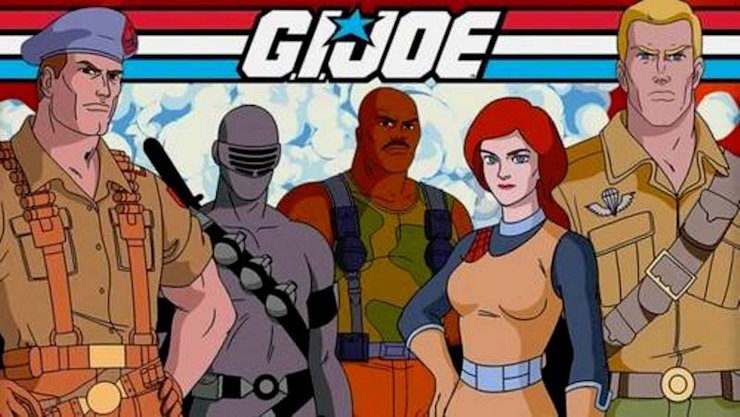G.I. Joe was one of my earliest loves. My grandmother gave me some of the comics, and that was it—I was hooked. I started asking for the action figures as presents, as well as the vehicles and playsets. And of course I started watching the cartoon! I remained a loyal fan for years, until 1987, when I decided that I had gotten too old for the Joes, and switched to Teenage Mutant Ninja Turtles.
Most childhood pleasures, when revisited, disappoint. But not G.I. Joe—well, not all of it.
Admittedly, the whole endeavor was first and foremost a glorified toy advert, a joint venture by Hasbro and Marvel Comics, who were trying to copy the smash success of Star Wars. The comics promoted the toys, and brief cartoon ads promoted the comics. When the ads proved popular, the company behind them, Griffin-Bacal, formed Sunbow Productions, which expanded the animated spots into longer cartoons.
I have yet, as an adult, to go back and rewatch every episode. But I have revisited some, the ones I best remember, and I’m pleased to report that they stuck with me for a reason. That’s largely a testament to the show’s creator, Ron Friedman, a skilled craftsman. He broke into the industry in 1963, and went on to write for numerous series, including Bewitched, All in the Family, Charlie’s Angels, and Fantasy Island. A TV veteran, he wasn’t afraid to suffuse G.I. Joe with idiosyncrasies and quirks, as well a self-avowed liberal politics. As he tells it, a childhood encounter with an anti-Semitic comic shop owner left him with a visceral dislike of discrimination and demagoguery, and he thought it important that G.I. Joe feature strong female characters and heroes from all walks of life. The Joes work together as a team, embracing difference, while the members of Cobra are petty and self-centered—aspiring autocrats out only for themselves.
Friedman also brought with him a talent for complex serial plotting—which might be common today on TV, but was practically unheard of in the 1980s, especially on a kid’s show. Friedman got the G.I. Joe gig in part because he convinced Sunbow to create a five-part miniseries, rather than just one 22-minute-long pilot. According to him, those additional minutes were crucial, affording him the time he needed to spotlight and develop the expansive cast (which had the added benefit of making kids more likely to buy the toys). Of course, the additional running time created its own problem, in that Friedman had to write a much longer story that could be broken up across episodes. In doing so, he braided together numerous smaller plots, which combine into a surprisingly intricate result.
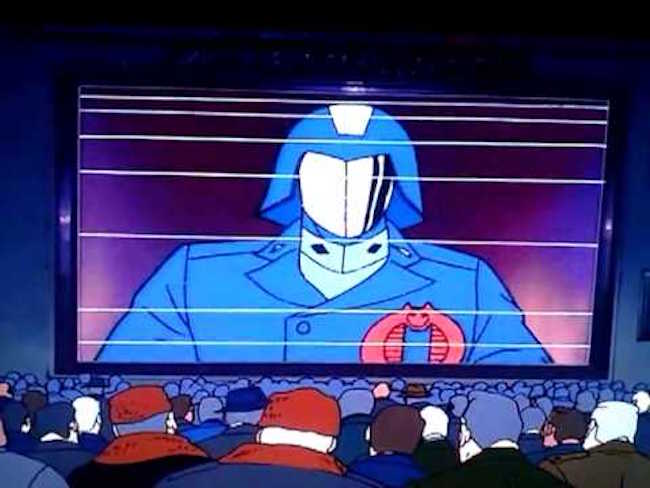
Take for instance the initial miniseries, which aired in September 1983. It’s a gloriously strange affair, a mash-up of adventure yarns and swipes from pop culture. It begins with Cobra constructing a doomsday machine, the M.A.S.S. Device, which can teleport matter around the world, as well as disintegrate objects. Cobra uses this machine to wreak havoc and kidnap various heads of state, prompting the Joes to fight fire with fire by assembling their own M.A.S.S. Device. Most of the miniseries sees the two sides racing to secure the three unique “catalytic elements” needed to power their respective devices.
Right from the start, the fact that the Joes need three elements, instead of just one, is a sign of Friedman’s skill. Not only does this decision further impede the Joes’ progress, it gives Friedman a means for showcasing different Joes on different missions. It also gives Friedman a means for controlling the story’s pace. Over the next two episodes, he cuts between the first and second missions, as well as Duke’s imprisonment at Cobra’s base, where Cobra Commander and Destro endlessly scheme and bickering. (A highlight comes when Destro, muttering under his breath, calls his fickle ally a “reptilian popinjay.”) This multifront approach prevents any single storyline from getting resolved too quickly, or from getting too bogged down.
Each plot is also clever, full of twists and surprises, never playing out in obvious ways. Consider the first mission, which plays out over the second through the fourth episodes. It begins when a team of five Joes, including Scarlett and Snake-Eyes, head north in search of the first element, a radioactive crystal found only deep inside an Arctic cave. Viewed broadly, the mission is simple: the Joes need to get some crystals, then get home. This being an action story, we expect our heroes to run into some trouble—inclement weather, a boobytrap, or Cobra forces.
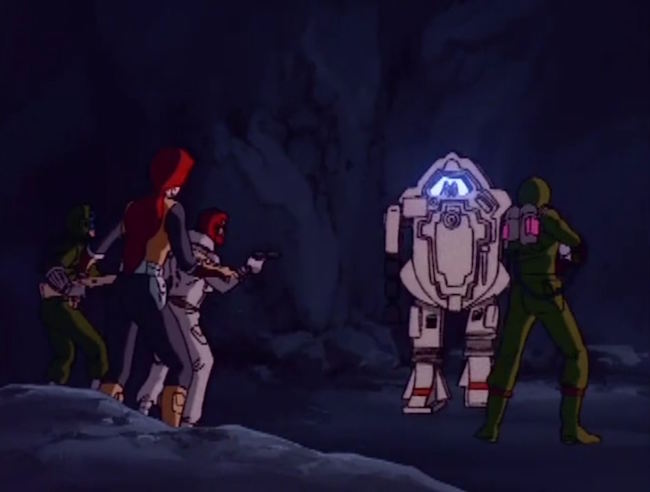
Friedman gleefully dumps all three to the mix. As soon as they enter the cavern, the Joes are attacked by laser guns, then trapped by a clanging steel barrier. Things go from bad to worse when camouflaged robot defenders—whose movements are accompanied by a distinctive tumbling sound—push the Joes deeper into the cave, where the radioactive crystals will do them in.
Working together, the Joes defeat the robots. A lesser writer would have stopped there, allowing the team to collect the crystals and return home. But Friedman still has twists up his sleeve. Snake-Eyes zooms off in a mining sled to retrieve the crystals while the other Joes work to blow up the steel barrier. The moment our heroes have gained their freedom, a Cobra team arrives, forcing the Joes back inside the cave. At the same time, the villainous Major Bludd detonates an explosive charge inside the mine, which unleashes a radioactive cloud and leaves the Joes with a painful choice: to remain in the cave “and learn to glow in the dark,” or fight their way through Cobra’s laser fire. They resolve to fight. Snake-Eyes, however, lowers a glass shield that seals off the back of the chamber, trapping himself with the cloud even as he saves his fellow Joes. (I’m guessing that Friedman swiped this bit from Star Trek II: The Wrath of Khan, which had come out the previous year. Snake-Eyes and Scarlett share a moment that directly recalls Spock and Kirk’s interaction in the film—
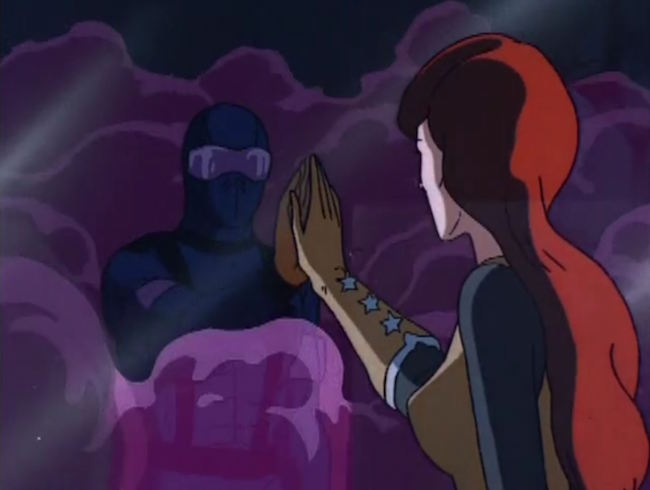
—that leads to Scarlett sobbing, an uncharacteristically weak moment.)
The lowering of the shield activates an emergency exit, allowing the Joes to escape. But—and this is the really brilliant part—they go home empty-handed, defeated and down a teammate. Such a setback seems especially unusual for a kid’s show, but it effectively raises the stakes. The Joes are now well behind Cobra, so even though Duke escapes from Destro and Cobra Commander’s clutches, and makes it back to Joe headquarters, our heroes—and the world—remain in real trouble.
Of course, back in the Arctic, Snake-Eyes is still alive. He collects some of the crystals in a cannister and, after evading more robots, exits the cave, crackling with radiation. The Cobra goons let him go, Major Bludd reasoning that he’s a dead man walking.
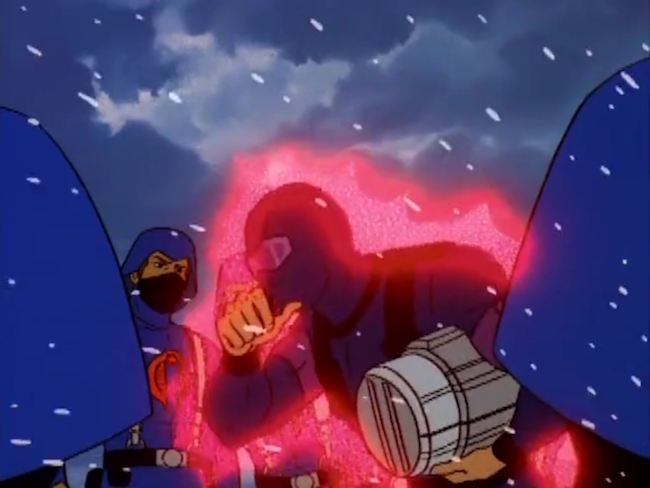
(This part’s admittedly clunky, and only works because it makes sense that the Cobra forces are afraid of Snake-Eyes.)
Snake-Eyes, glowing fiercely, stumbles through the Arctic wilderness, eventually falling down a cliff. This part is pure Jack London, so it’s appropriate that the ninja lands directly in front of a snarling wolf, whose paw is caught in a trap. Snake-Eyes starts to leave, then turns back and frees the wolf, who follows him. But then the two are attacked by an utterly massive polar bear, which smacks them around—
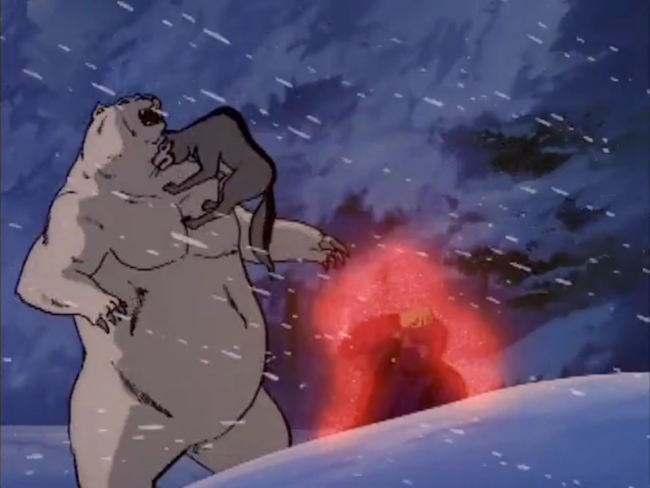
—until a stranger arrives and drives off the bear with a cattle prod-like tool.
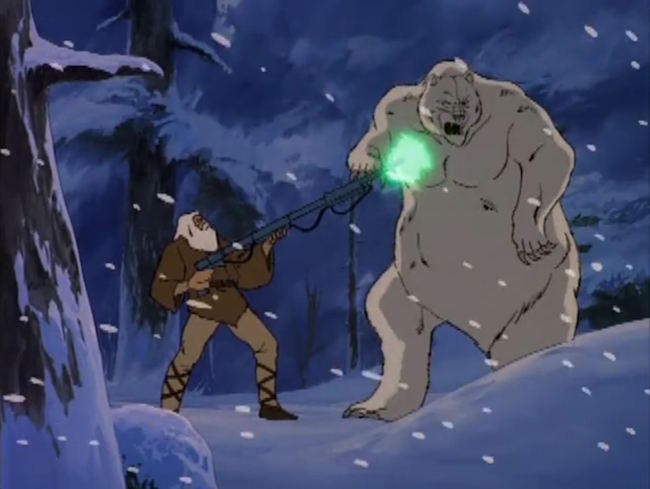
Speaking in a terrible Scottish accent, this mysterious man loads Snake-Eyes onto his dogsled and takes him home, where he cures the ailing ninja of his radiation sickness with “a simple dressing of leaves and herbs.” He also names the wolf Timber (“Tis a perfect moniker!”), and hands Snake-Eyes the cannister with the crystals, which had been temporarily lost in a small avalanche.
Whew! Thus equipped, Snake-Eyes, accompanied by Timber, makes his way back to Joe headquarters. Mission accomplished—almost. Friedman isn’t done yet. The cannister containing the crystals turns out to be yet another boobytrap, which emits fumes with “paralyzing properties” and, what’s worse, is rigged to explode. The Joes are incapacitated, but Timber helps save the day, working with Cover Girl to launch the trap out of the base before it detonates. (This scene contains a charming error, in which two copies of Timber appear together onscreen.)
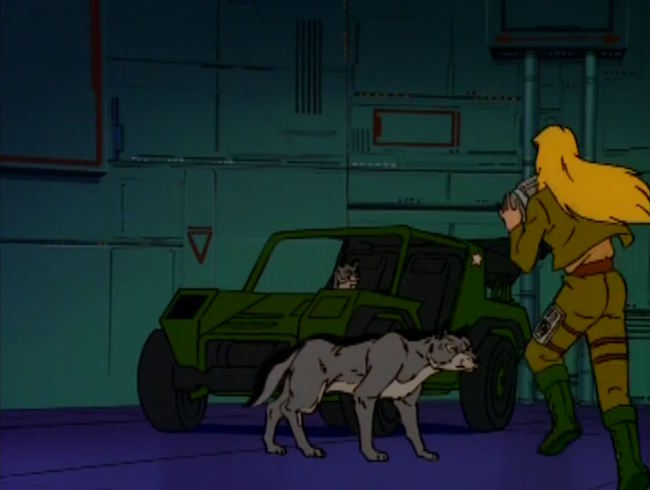
This moment of heroism is a perfect example of why Friedman wanted the extra running time: it not only brings the mission to a close, it also showcases Cover Girl and Timber, and helps make the wolf an ally to the Joes.
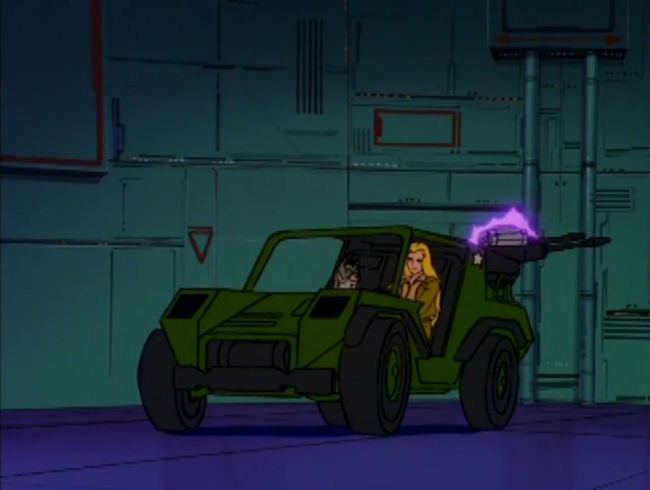
The rest of the miniseries is just as fun, featuring (among other things) gladiatorial combat, mind control, a meteorite, a volcano, and giant shrieking tube worms. The show’s success led Sunbow to produce a second miniseries, “The Weather Dominator” (1984), also written by Friedman, and then a regular series that started airing in 1985, which featured more of Friedman’s work. (It also featured episodes by Steve Gerber, the creator of Howard the Duck, who penned the two-part “There’s No Place Like Springfield,” a trippy reworking of The Prisoner.) All involved worked to keep the production levels high, and that commitment to craft is why G.I. Joe is remembered so fondly today—why people still collect the toys, and cosplay as Scarlett and Snake-Eyes and the Baroness and Destro. Given that, it’s not surprising that Hasbro is still trying to revamp the franchise into an ongoing live-action film series. They should borrow a page or two from the original cartoon, and give us lifelong fans weirdly complex tales with strange creatures, boobytraps, setbacks, and indelible, idiosyncratic characters—that is to say, something as good as what Friedman made.
 A. D. Jameson is the author of several books, including Cinemaps, a collaboration with the artist Andrew DeGraff. A former blogger for HTML Giant, his fiction has appeared in Conjunctions, Denver Quarterly, Unstuck, and elsewhere. His latest book, I Find Your Lack of Faith Disturbing, celebrates the triumph of geek culture. He is a PhD candidate in the Program for Writers at the University of Illinois in Chicago.
A. D. Jameson is the author of several books, including Cinemaps, a collaboration with the artist Andrew DeGraff. A former blogger for HTML Giant, his fiction has appeared in Conjunctions, Denver Quarterly, Unstuck, and elsewhere. His latest book, I Find Your Lack of Faith Disturbing, celebrates the triumph of geek culture. He is a PhD candidate in the Program for Writers at the University of Illinois in Chicago.










